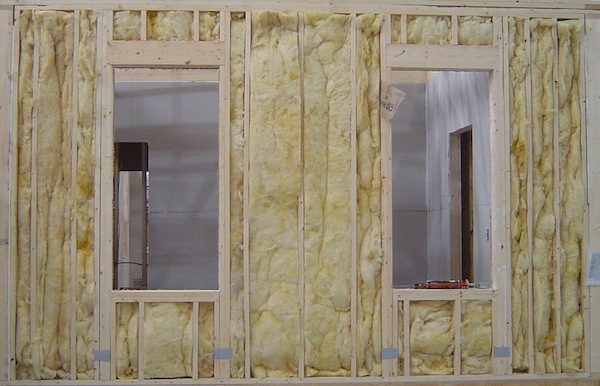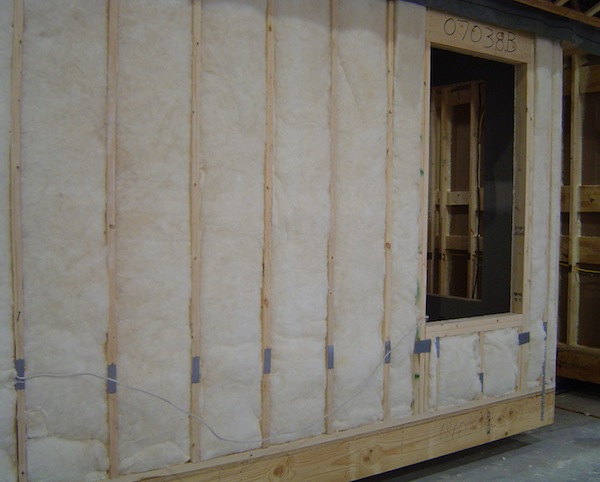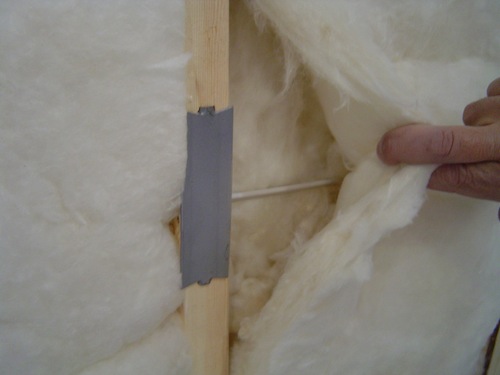Who’s on Your Insulation Crew?

I used to do some consulting with a modular home manufacturer. We first visited their plant in 2007, and, as you can see below, they didn’t quite have the insulation installation thing down. What you see below would be Grade III installation quality according to this insulation installation grading protocol. Six months later, Mel, their plant engineer, made an illuminating remark to me about why their insulation looked like that and how they changed it.
The main problem with the insulation above is all the compression. The fiberglass batts are cut a bit short in a few places, but stuffing batts that are too wide into the wall cavities above, which also results in areas where the insulation doesn’t completely fill the cavity, is the main problem here. You’re not going to get the rated R-value with an installation like that.
But this modular builder cleaned up their act. I visited the same plant again six months later and took the photos below.

Isn’t that beautiful! That’s how insulation should be installed. Of course, you can’t look only at the surface. Sometimes what lies beneath is really ugly. In this case, however, they’d done it right all the way through. In the photo below, you can see that they’d split the fiberglass batt to let the wire go through the insulation rather pressing the batt against the wire and leaving a big void behind.

What was their secret? How did this modular builder go from Grade III insulation installation to Grade I in six months? When I was at the plant that second time, Mel told me, “We used to put our worst guys on the insulation crew. Now we make sure that some of our best workers are there to make sure it’s done right.”
Behind that statement, though, is perhaps a more important truth: When the company realized the importance of good installation quality, they did what they needed to do to make that happen. Yes, they changed the crews, but they also provided a lot of guidance on proper installation.
It wasn’t merely changing the workers. It was a change of attitude in the company.
Allison A. Bailes III, PhD is a speaker, writer, building science consultant, and the founder of Energy Vanguard in Decatur, Georgia. He has a doctorate in physics and is the author of a popular book on building science. He also writes the Energy Vanguard Blog. You can follow him on Twitter at @EnergyVanguard.
Related Articles
How to Grade the Installation Quality of Insulation
A Visual Guide to Why Fiberglass Batt Insulation Underperforms
Rare Grade I Fiberglass Batt Insulation Sighting
NOTE: Comments are moderated. Your comment will not appear below until approved.
This Post Has 15 Comments
Comments are closed.

This goes back many, many
This goes back many, many years to when insulation was a poorly understood requirement that slowed the construction process.
A few companies found that by buying insulation in huge quantities and using low cost labor they could get insulation into homes quickly at a reasonable cost. Often the installed cost would be only slightly more than what the builder would pay for materials alone.
Builders loved the fast turn around and the price. Even better there was often another insulator vying for their business by lowering the price. Voila! Insulation was a commodity.
This mindset still persists to this day; although inroads have been made. Until the way builders think about insulation changes we’re not going to resolve this problem.
I was on a consult last week
I was on a consult last week where the insulation contractor said, “we’ll said out our ‘A’ crew.”
After they had left, the homeowner and I both noted that that means that they have a B team and, yes, probably a C, D and F team.
What is the value of “better”
What is the value of “better”?
“Mel, their plant engineer, made an illuminating remark to me about why their insulation looked like that and how they changed it.”
What was the why? How did they quantify the value of going from picture 1 to picture 2?
Allison, did you do this to show us you are still human, capable of a less than stellar blog post? I’m suspicious…
Bill S.: Yup. Same is true of
Bill S.: Yup. Same is true of HVAC.
Erik N.: They do it right when they have to.
Ted K.: Do I really need to explain the RESNET insulation installation grading protocol every time when I’ve already written about it and I linked to it within the article and included it as the first one in the list of related articles?
It is a shame that all
It is a shame that all manufacturers and service providers do not think of EVERY aspect of their business as “needing their best workers”. First rules of management: get good people, train them properly, leave them alone (AKA do not micromanage), keep them happy so they stay with you. If you do not have good employees for a particular function, replace them. If good employees are not happy and keep leaving you, change your internal business operations.
David E.: I’m totally with
David E.: I’m totally with you on that!
Allison, Another
Allison,
Another significant take-away from the two photos is how much of the wall area consists of nothing but lumber (!). I believe you have run the numbers on this before in regard to the effective R value of the entire wall. The second link you added addresses my question qualitatively, but a range would be informative. Am I going off the rez with this question?
And at the risk of broadcasting my ignorance, although I’ve never let that stop me before, what are the gray items on the verticals? I’m inclined to think they serve to reinforce the timber, where wiring clearance was provided (as shown in the third photo) but in the second photo wiring is sagging in front of “whatever they are”.
Please enlighten me.
Best wishes.
Steve W.: I’ve discussed
Steve W.: I’ve discussed thermal bridging but not quantitatively yet. It’s on my list. I did write about a related topic, average R-value of uniformly vs. non-uniformly distributed insulation, and maybe that’s what you’re thinking of.
Those gray items are steel plates to prevent nails from going into the wiring. It makes it really easy to find the places you need to inspect the insulation to see how they handled the wiring, as you can see in the third photo above.
Question. Assuming the blower
Question. Assuming the blower door numbers are the same, what is the difference in energy usage between Grade 1 and Grade 3? Are we talking $1/yr or $100/yr, or some other figure? In other words, how much does it affect building performance?
Production homes are a fast build with limited time, is the time better spent tightening the enclosure rather than on pretty fiberglass?
Nate A.: We just played with
Nate A.: We just played with the HERS rating software we use, REM/Rate, and found that going from Grade I to Grade III in Cleveland, Ohio increases your heating bill about 8%. In the 3300 square foot house we looked at, the annual heating cost went from $1342 to $1453. If the house lasts 50 years, that adds up to a lot of money. I’m sure the net present value would be positive.
Air-sealing is definitely important, especially with air-permeable insulation like fiberglass. Air-sealing is usually the most cost-effective thing you can do to improve a home’s energy efficiency. But I’m sure you knew that already.
How about a little more free
How about a little more free consulting? =) If you still have that house up, what’s the value of that house being say, 2700 cfm50 vs. 3600 (a 25% difference) or 3240, a 10% difference?
That would give more of an apples to apples comparison to Grade 1 vs. Grade 3. Also, on Grade 3, what is it that really affects it, the squashed insulation or the missed areas?
And thanks for running the simulation!
Hmmm. None of those number
Hmmm. None of those number line up for me.
– 3000 sf home with $1400 hvac consumption in Ohio is a pretty crappy home.
– Most mobile homes I’m familiar with are 800-1800 sf. I have a client with an 1800 sf 20 year old double wide who spends $600 total gas bill.
– 8% seem a lot of savings for a tiny improvement in wall r-value. How much is the percentage total thermal loss due to that component? Is it even 15% on a mobile home?
If you throw in some air sealing, windows, and a setback thermostat, pretty soon they’ll be saving $2000? (I have seen audits promising savings of $1200 to people whose total spend is $900, is that the road we want to follow?)
I’m sorry but spending time teaching pretty fiberglass install is like using dog crap to frost a cake, and then giving out awards for prettiest cake. Perhaps we might focus on better cake, even if it means NO frosting.
People have limited bandwidth. I think this training time might have been much better allocated by teaching the importance of air sealing. Don’t we want our primary efforts spent correcting common perceptions about what matters?
How many have actually seen before and after bills? That mobile home I mentioned? We cut their bill 40%. No insulation changes. http://bit.ly/tedkiddresults
Lets help direct people to stop chasing pennies when there are dollar bills at their feet.
I sure wish the concept of
I sure wish the concept of grading insulation would migrate across the 49th parallel.
Thanks for bringing attention to a story that needs to be told!
Allison, Im happy to hear
Allison,
Im happy to hear you have been able
to affect change with a company in
the building industry. When the
installer cares about the install
of anything they will always do
better work. During my years as an
commercial HVAC foreman, I had the
opportunity everyday to teach
quality installation, and having
pride in what you do. It was called
Pride In Workmanship, a concept
that has seemed to gone away. We
raters, auditors, and inspectors
have the opportunity to teach good
building practices and should
whenever given the opportunity.
We frequently hear the
We frequently hear the response of the A crew or B Crew! We have also done some modular and suggested the advanced framing but got a lot of push back from the Super and Engineer- they are worried about too much flex during transportation…
Great article Allison!